Segni di segni
Exhibition at Ivorypress Space
6 June 2013 – Madrid
New Pages in the Book of Nature. For years Pia Gazzola has been collecting on paper the traces left by the movement of different types of plants whose leaves, with their ends of covered in ink, act as instruments of graphic expression that are able to capture configurations that react to the flexibility of the vegetable fibres in the bre- eze or the wind. In this way, they provide us with an inventory of the ways in which some common and familiar plants move, dance or ‘write’. It’s a wonderful endeavour that is specified in a book of prints that describes the effects that her device has produced. The artist, Pia Gazzola, has achieved a visual repertoire that relates to the vivacity inherent in the way in which trees, bushes, plants, branches and leaves blow in the wind. The distinct behaviours of these organic, natural beings are shown as enigmatic hieroglyphics drawn with their limbs and offered to us for our curiosity and delight. These singular traces and stains arise from the original characteristics of their activity. Each plant generates its own graphic territory, defined by actions and reactions, by the amplitude and the rhythm of forces that are more or less predictable or arbitrary. Thus, they create the outline of a phenomenology that is determined by weight, resistance, the sliding of paper, pressure or sudden liberations and everything regarding the struggle between the fibres and the wind, its velocity and the way it blows. A drawing is always created by an instrument driven by the hand, but here the instrument is a leaf or the extremity of a plant with fresh ink on its tip. Pia has set in motion something resembling a puppet show. The exemplarity and the instructive value of the puppet had already become apparent in the famous text by Heinrich von Kleist in which he showed how the movements of the doll, resulting from the impulses transmitted by the strings pulled by the puppeteer, acquire a special grace through the interference of gravitational force.1 Its limbs follow pendular trajectories according to mechanical laws of nature and its dance appears even more harmonious that of the rigid or obstinate steps of the inexperienced dancer of flesh and bone. The puppet thus becomes the true master of dance, following in the example or the authority of the human contender.
These prints by Pia Gazzola illustrate, in a literal way, the old metaphor of Nature as a book. Everyone knows that the authority of this book has been profoundly revered since ancient times. It is the authority that, for instance, protects and justifies the desire for immortality of lovers when they carve their names into the bark of a tree. They aspire to place themselves within its everlasting pages.2
It has also been said that the stars are letters of a universal book that humankind has always tried to decipher. We can recall the beautiful image of Plotinus, who regarded the stars as letters inscribed on the heavens; an alphabet fixed in the passing of time and at the same time, compound words that wander along the all-encompassing base of the stellar movements. Now Pia would like to add some new pages to this book. She has extended this metaphor by emphasising a space of significance in which to incorporate true signs of beings that are close to us but also as silent and reserved as the celestial bodies of the firmament.
The doodles of children have been studied, analysed and classified in a rigorous and systematic way.3 Graphemes, the minimum variables that characterise the expression of children’s drawings, constitute a group where figures abound, a world that seems free but that is actually, at its core, finite and fenced-in. Upon reaching adulthood a mutation takes place, and at the same time the doodle continues to coexist symbiotically with figurative drawings and with writing. In the first case, because the creation is infiltrated by traces of the artist’s organic expressiveness that are spontaneous, not premeditated. This hap- pens, for instance, in Klee’s line drawings, which have a seismographic sensibility, in the manual ease of De Kooning’s brushstrokes, or in the flecks and stains produced by the whimsical drumming of the paintbrush, in Motherwell’s case.4 The doodle is installed in writing as well. It enriches its territory by turning calligraphy into an art of the body with splendid manifestations in many cultures.
Leonardo’s drawings that reproduce vortices in the water are well known. Their lines trace the same curves activated by liquid energy. The lines that guide the painter’s hand recreate an agitation similar to that of aquatic turbulences.
The paintings and drawings of the artistic practices mentioned, in reference to an external world or to the intimate, organic nature of doodling, express their true yearning by way of the intervention of a hand. However, some artists inhibit their presence and long, in a way, to be absent, in order to make their message easier and more neutral. This objective is achieved in the book that Pia Gazzola has made ‘hands-free’. There is no representation in this book, no intervention of bodily expression; there is a direct transportation of mobility to the paper. With her communicative initiatives Pia proposes the contemplation of Nature and its authority through the transparency of a direct, immediate step.
These drawings are sheet music and texts. They are sheet music for a melody and dance that is collected time and time again in lines that are interpreted in a similar way by each vegetable species in analogous environmental situations. They are also texts that, just like Kleist’s marionettes, have an animation that contains a deposit of teachings and exemplarity. This book of vegetable sketches serves not only as a drawing method that is rigorous and faithful but also, because of its inherent authority, to incite us to behave with the courageousness of a fluid naturalness. It is not surprising that these singular and concrete prints have a universal validity: we perceive within them the deep universality of a kingdom that is restless, bustling, held captive by differences which, when perceived as a whole, are brought together as a faraway murmur that is united by the wind.
Juan Navarro Baldeweg
1 Heinrich von Kleist, ‘The Puppet Theatre’, in Selected Writings, trans. and ed. David Constantine (Indianapolis: Hackett Publishing Company, 2004).
2 Rensselaer W. Lee, Names on Trees: Ariosto Into Art (Princeton: Princeton University Press, 1977). 3 Rhoda Kellogg and Scott O’Dell, The Psychology of Children’s Art (San Diego: CRM–Random House, 1967). 4 David Rosand, The Meaning of the Mark: Leonardo and Titian (Lawrence: Spencer Museum of Art. University of Kansas, 1988).
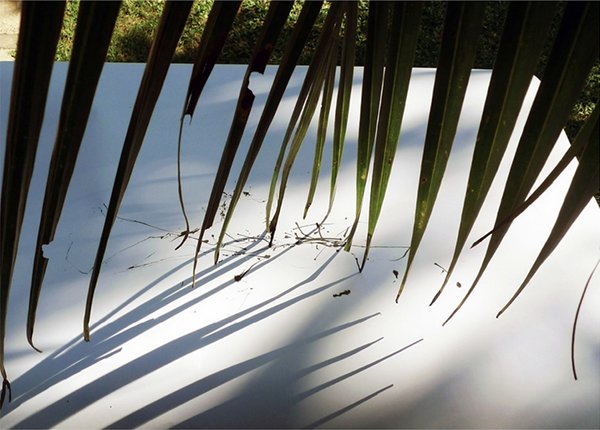
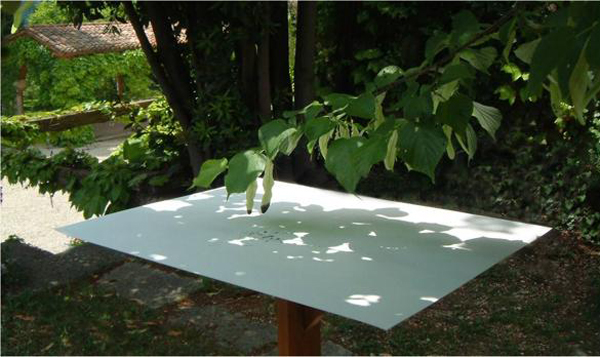
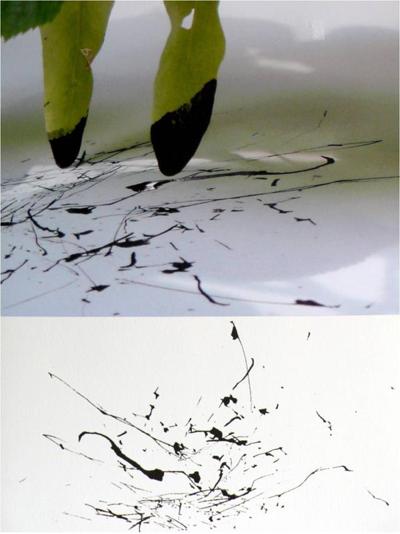
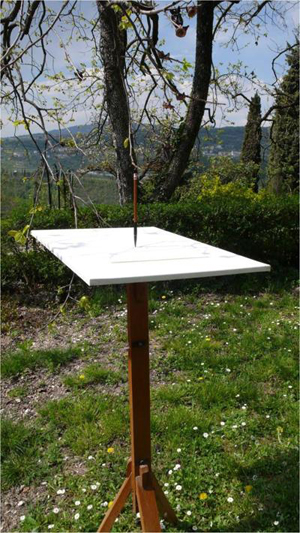
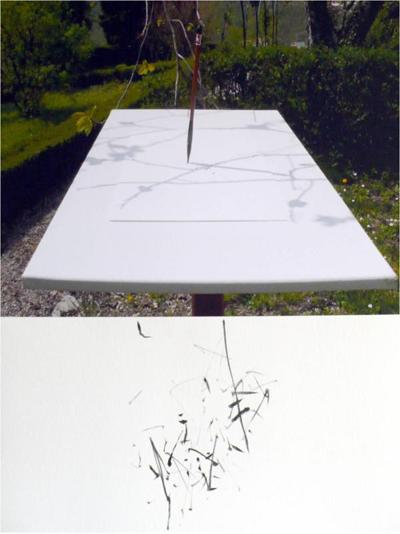
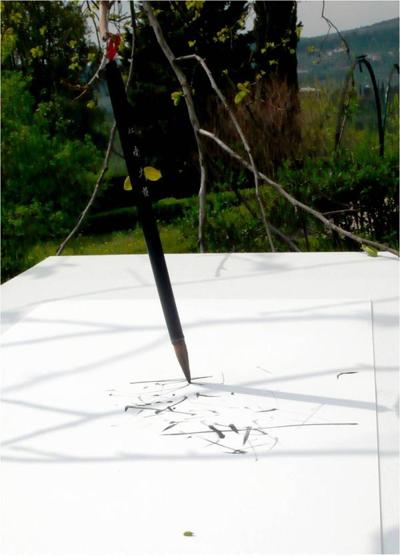
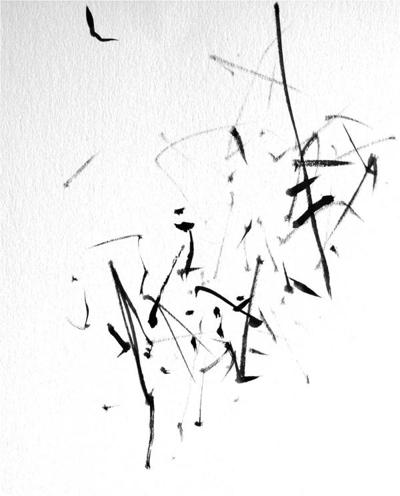
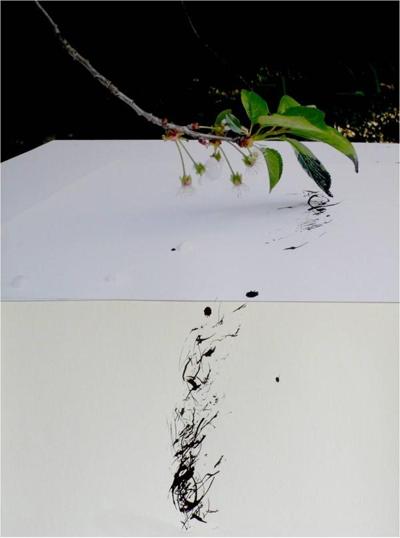
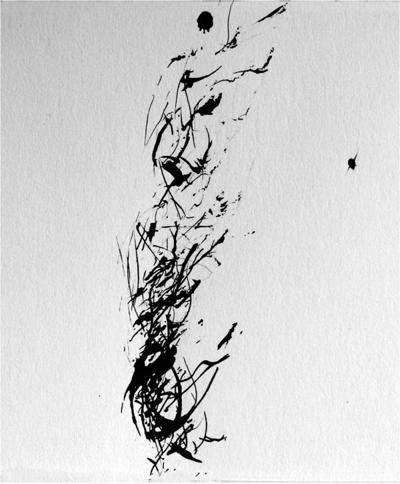
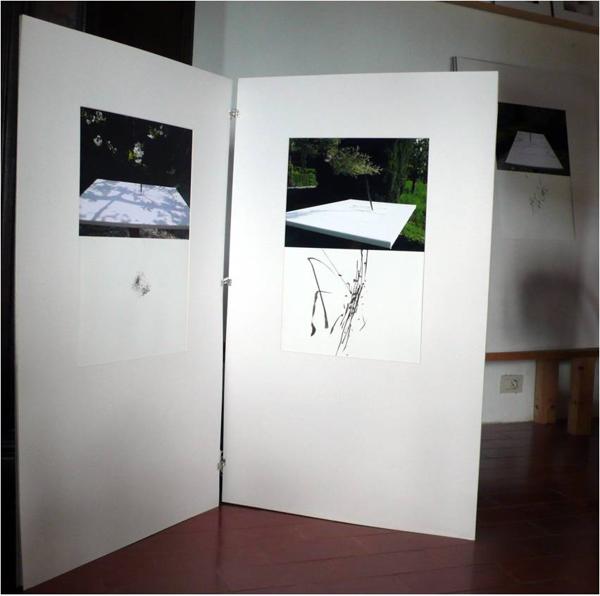
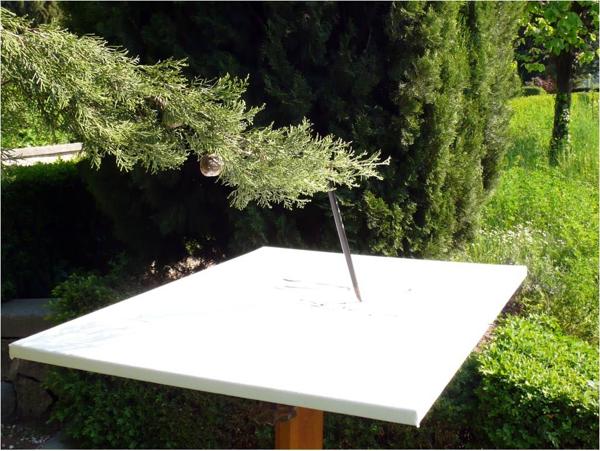
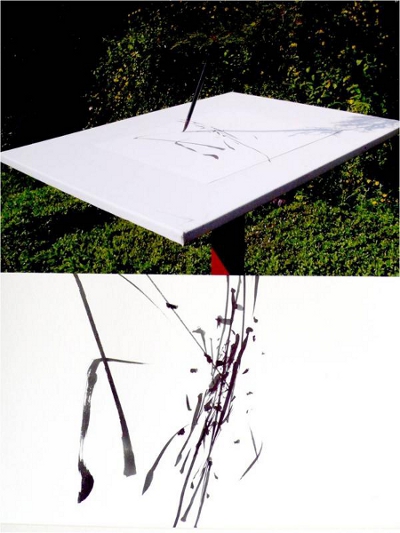
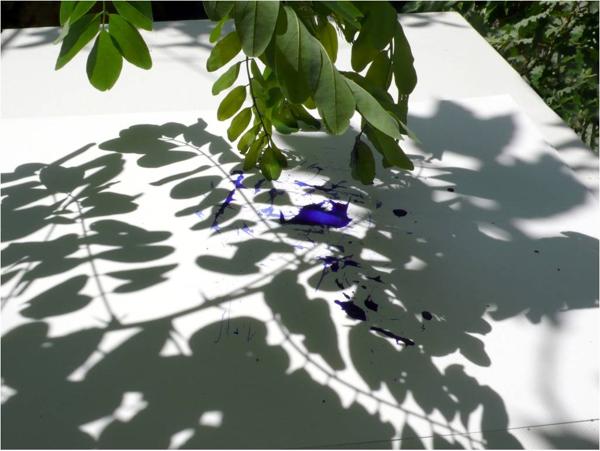
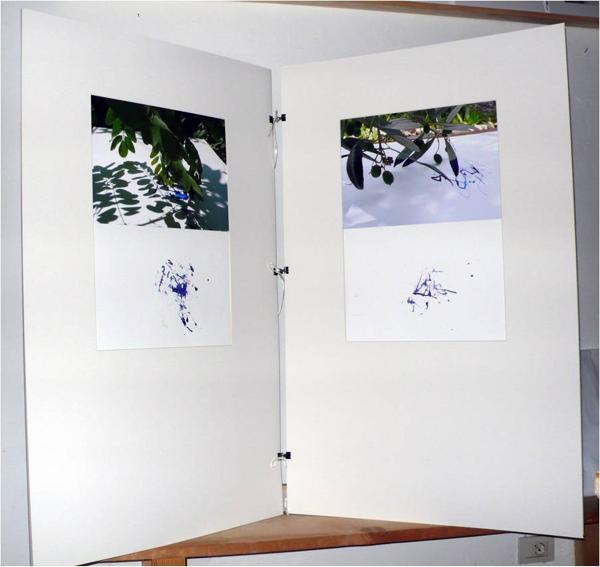
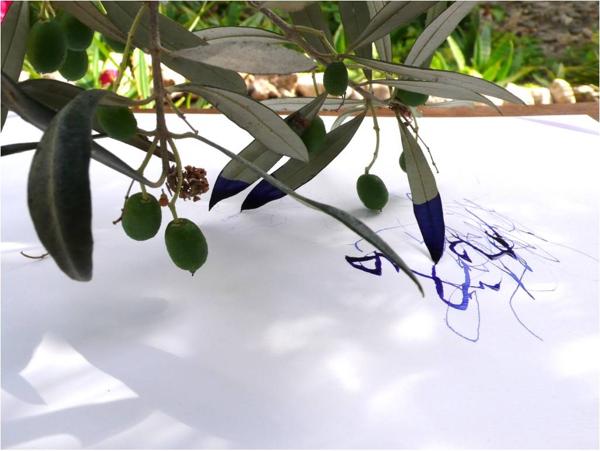
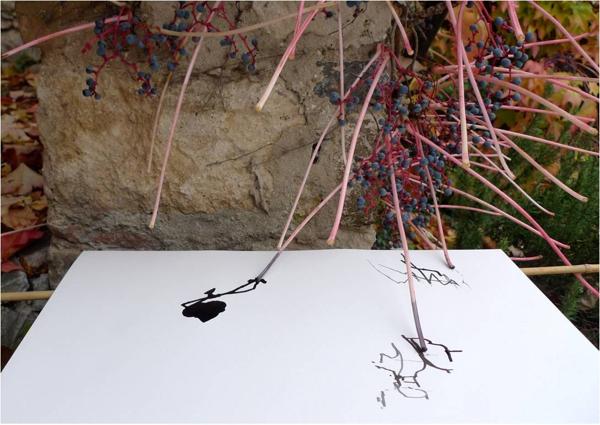
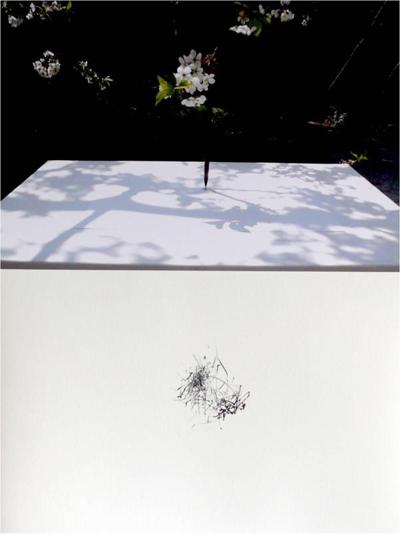
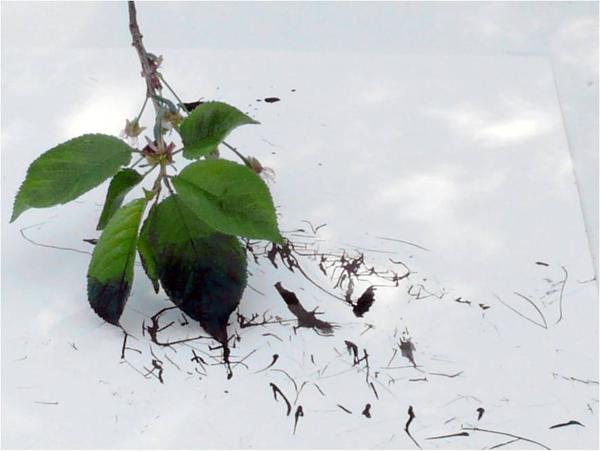
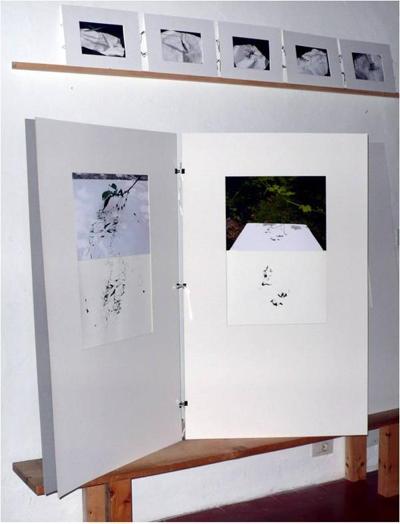
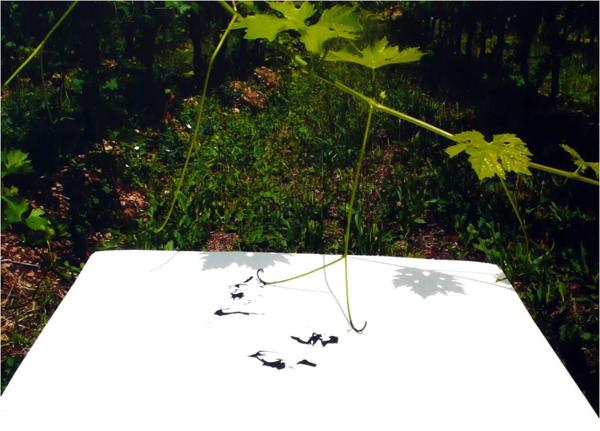
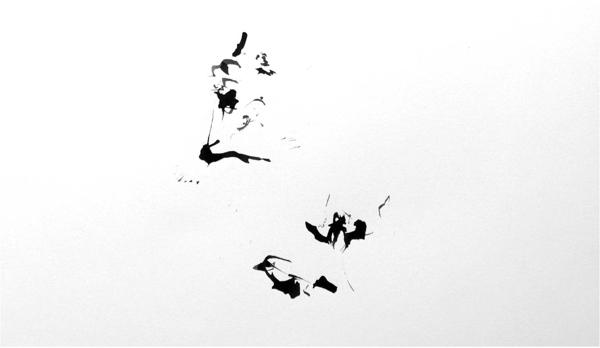
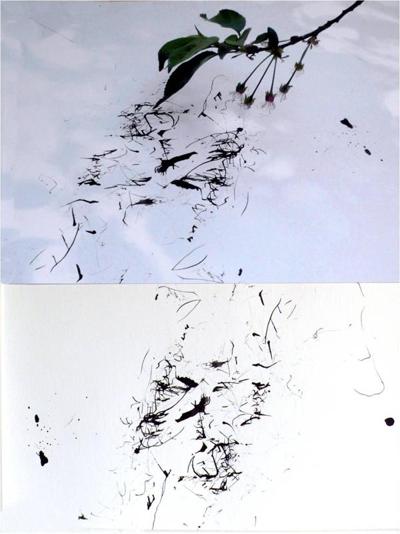
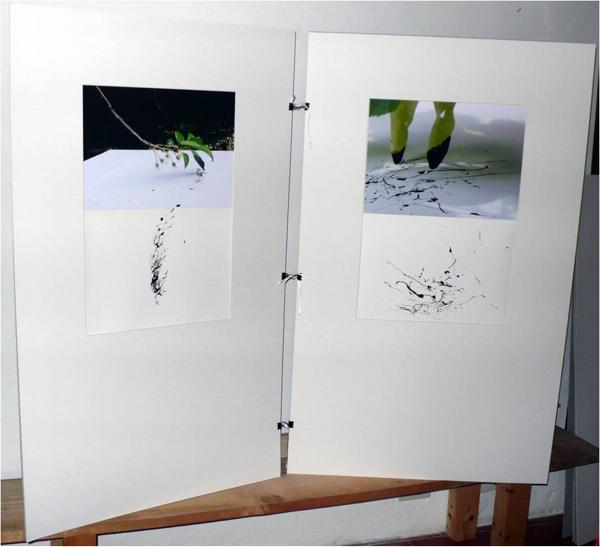
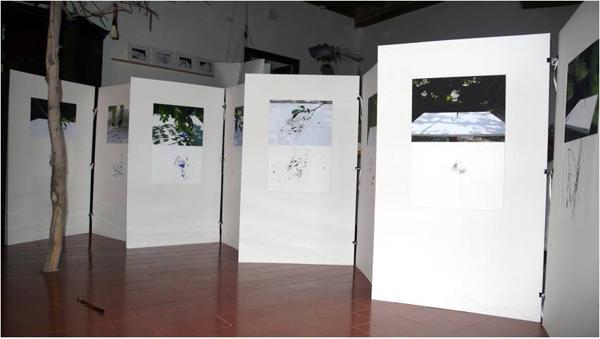
Segni di segni
Exhibition at Ivorypress Space
6 June 2013 – Madrid
New Pages in the Book of Nature. For years Pia Gazzola has been collecting on paper the traces left by the movement of different types of plants whose leaves, with their ends of covered in ink, act as instruments of graphic expression that are able to capture configurations that react to the flexibility of the vegetable fibres in the bre- eze or the wind. In this way, they provide us with an inventory of the ways in which some common and familiar plants move, dance or ‘write’. It’s a wonderful endeavour that is specified in a book of prints that describes the effects that her device has produced. The artist, Pia Gazzola, has achieved a visual repertoire that relates to the vivacity inherent in the way in which trees, bushes, plants, branches and leaves blow in the wind. The distinct behaviours of these organic, natural beings are shown as enigmatic hieroglyphics drawn with their limbs and offered to us for our curiosity and delight. These singular traces and stains arise from the original characteristics of their activity. Each plant generates its own graphic territory, defined by actions and reactions, by the amplitude and the rhythm of forces that are more or less predictable or arbitrary. Thus, they create the outline of a phenomenology that is determined by weight, resistance, the sliding of paper, pressure or sudden liberations and everything regarding the struggle between the fibres and the wind, its velocity and the way it blows. A drawing is always created by an instrument driven by the hand, but here the instrument is a leaf or the extremity of a plant with fresh ink on its tip. Pia has set in motion something resembling a puppet show. The exemplarity and the instructive value of the puppet had already become apparent in the famous text by Heinrich von Kleist in which he showed how the movements of the doll, resulting from the impulses transmitted by the strings pulled by the puppeteer, acquire a special grace through the interference of gravitational force.1 Its limbs follow pendular trajectories according to mechanical laws of nature and its dance appears even more harmonious that of the rigid or obstinate steps of the inexperienced dancer of flesh and bone. The puppet thus becomes the true master of dance, following in the example or the authority of the human contender.
These prints by Pia Gazzola illustrate, in a literal way, the old metaphor of Nature as a book. Everyone knows that the authority of this book has been profoundly revered since ancient times. It is the authority that, for instance, protects and justifies the desire for immortality of lovers when they carve their names into the bark of a tree. They aspire to place themselves within its everlasting pages.2
It has also been said that the stars are letters of a universal book that humankind has always tried to decipher. We can recall the beautiful image of Plotinus, who regarded the stars as letters inscribed on the heavens; an alphabet fixed in the passing of time and at the same time, compound words that wander along the all-encompassing base of the stellar movements. Now Pia would like to add some new pages to this book. She has extended this metaphor by emphasising a space of significance in which to incorporate true signs of beings that are close to us but also as silent and reserved as the celestial bodies of the firmament.
The doodles of children have been studied, analysed and classified in a rigorous and systematic way.3 Graphemes, the minimum variables that characterise the expression of children’s drawings, constitute a group where figures abound, a world that seems free but that is actually, at its core, finite and fenced-in. Upon reaching adulthood a mutation takes place, and at the same time the doodle continues to coexist symbiotically with figurative drawings and with writing. In the first case, because the creation is infiltrated by traces of the artist’s organic expressiveness that are spontaneous, not premeditated. This hap- pens, for instance, in Klee’s line drawings, which have a seismographic sensibility, in the manual ease of De Kooning’s brushstrokes, or in the flecks and stains produced by the whimsical drumming of the paintbrush, in Motherwell’s case.4 The doodle is installed in writing as well. It enriches its territory by turning calligraphy into an art of the body with splendid manifestations in many cultures.
Leonardo’s drawings that reproduce vortices in the water are well known. Their lines trace the same curves activated by liquid energy. The lines that guide the painter’s hand recreate an agitation similar to that of aquatic turbulences.
The paintings and drawings of the artistic practices mentioned, in reference to an external world or to the intimate, organic nature of doodling, express their true yearning by way of the intervention of a hand. However, some artists inhibit their presence and long, in a way, to be absent, in order to make their message easier and more neutral. This objective is achieved in the book that Pia Gazzola has made ‘hands-free’. There is no representation in this book, no intervention of bodily expression; there is a direct transportation of mobility to the paper. With her communicative initiatives Pia proposes the contemplation of Nature and its authority through the transparency of a direct, immediate step.
These drawings are sheet music and texts. They are sheet music for a melody and dance that is collected time and time again in lines that are interpreted in a similar way by each vegetable species in analogous environmental situations. They are also texts that, just like Kleist’s marionettes, have an animation that contains a deposit of teachings and exemplarity. This book of vegetable sketches serves not only as a drawing method that is rigorous and faithful but also, because of its inherent authority, to incite us to behave with the courageousness of a fluid naturalness. It is not surprising that these singular and concrete prints have a universal validity: we perceive within them the deep universality of a kingdom that is restless, bustling, held captive by differences which, when perceived as a whole, are brought together as a faraway murmur that is united by the wind.
Juan Navarro Baldeweg
1 Heinrich von Kleist, ‘The Puppet Theatre’, in Selected Writings, trans. and ed. David Constantine (Indianapolis: Hackett Publishing Company, 2004).
2 Rensselaer W. Lee, Names on Trees: Ariosto Into Art (Princeton: Princeton University Press, 1977). 3 Rhoda Kellogg and Scott O’Dell, The Psychology of Children’s Art (San Diego: CRM–Random House, 1967). 4 David Rosand, The Meaning of the Mark: Leonardo and Titian (Lawrence: Spencer Museum of Art. University of Kansas, 1988).